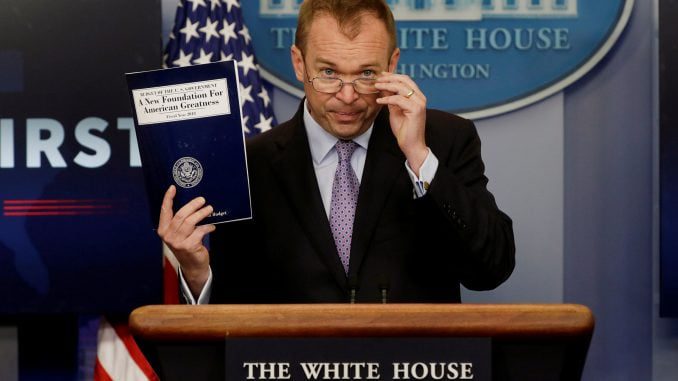
In presenting President Donald Trump’s first budget to the House Budget Committee last week, Office of Management and Budget Director Mick Mulvaney said that it “keeps the president’s promise to balance the budget within the next decade and reduce our debt without affecting beneficiaries of Social Security and Medicare retirement programs, and without raising taxes.”Unfortunately, the budget relies on improbable assertions of higher economic growth and unrealistic assumptions about future spending cuts to achieve its goal. However, even taking the budget at face value, one little-noticed effect of the president’s budget is the extent to which his pledge to leave Social Security and Medicare largely alone, while imposing deep cuts elsewhere in the budget, results in those two programs consuming an escalating share of the budget.To be sure, Social Security and Medicare would consume a growing share of the budget regardless, due to an aging population and the fact that the cost of health care services tends to grow faster than the economy.Trump’s budget policies, however, would take this trend and make it more pronounced. Social Security and Medicare would grow from 41 percent of primary (non-interest) spending in 2017 to 49 percent in 2027. Under the president’s budget policies, however, those two programs would consume 57 percent of primary spending by 2027.Budget analysts have long warned that attempting to bring federal deficits under control without touching Social Security and Medicare or raising taxes would require dramatic cuts in other programs.As far back as 1994, the Bipartisan Commission on Entitlement and Tax Reform, chaired by then-senators Bob Kerrey and Jack Danforth, who now are co-chairs of The Concord Coalition, warned: “To ensure that funds are available for essential and appropriate government programs, the nation cannot continue to allow entitlements to consume an increasing share of the federal budget.”The Trump budget validates this warning. Social Security and Medicare, the two largest “entitlement” programs, are the only two spending categories that grow faster than the economy. Appropriations for defense and nondefense programs would both be cut to the lowest level as a share of the economy since this statistic was first recorded in 1962. Other entitlement programs, including Medicaid, would also be cut relative to current law.In total, primary spending other than Social Security and Medicare would be reduced from 11.7 percent of GDP in 2017 to 7 percent in 2027, a precipitous and unprecedented decline.Two questions arise from this scenario: Is it politically feasible to count on cuts of this magnitude being enacted, and even assuming that it could be done would it be wise policy?The answer to both questions is: probably not. Hollowing out the rest of the budget to wall off the two fastest-growing programs would put a disproportionate burden on all other priorities. Defense, domestic investments and safety-net programs will all feel the pinch.If the point of the president’s budget is to “make America great again,” it should be noted that in the presumably greater days of 30 or 50 years ago, much more of the budget went to discretionary programs and much less of it went to Social Security and Medicare.That doesn’t mean that Social Security and Medicare should be cut back to prior times when the demographic picture and health care costs looked much different. It does mean, however, that as circumstances change no part of the budget should be exempt from scrutiny.It is true that unlike most programs, Social Security and Medicare have dedicated revenue sources. These resources, however, are not enough to cover current expenses, and the gap will only deepen. Thus as the programs consume a greater share of federal spending, they will also consume a greater share of general revenues.Under the Trump budget, Social Security and Medicare would rise in cost from 8 percent of GDP this year to 9.4 percent in 2027. Combined payroll taxes for Social Security and Medicare Part A would remain flat at 5.8 percent of GDP. Premiums for Medicare Parts B and D are set by law to cover just 25 percent of program costs.Pledging not to touch Social Security and Medicare leaves both programs on an unsustainable path.Oddly enough, in putting a rosy glow on its own budget, the administration concedes an important downside to the long-term outlook: “Despite all the progress the budget proposals make toward fiscal goals, some long-term challenges remain, particularly in Social Security and Medicare.”In other words, the administration acknowledges the problem while proudly proclaiming its intention to do nothing about it.Robert Bixby is executive director of The Concord Coalition, a nonpartisan organization that helps educate the public about the federal budget.



